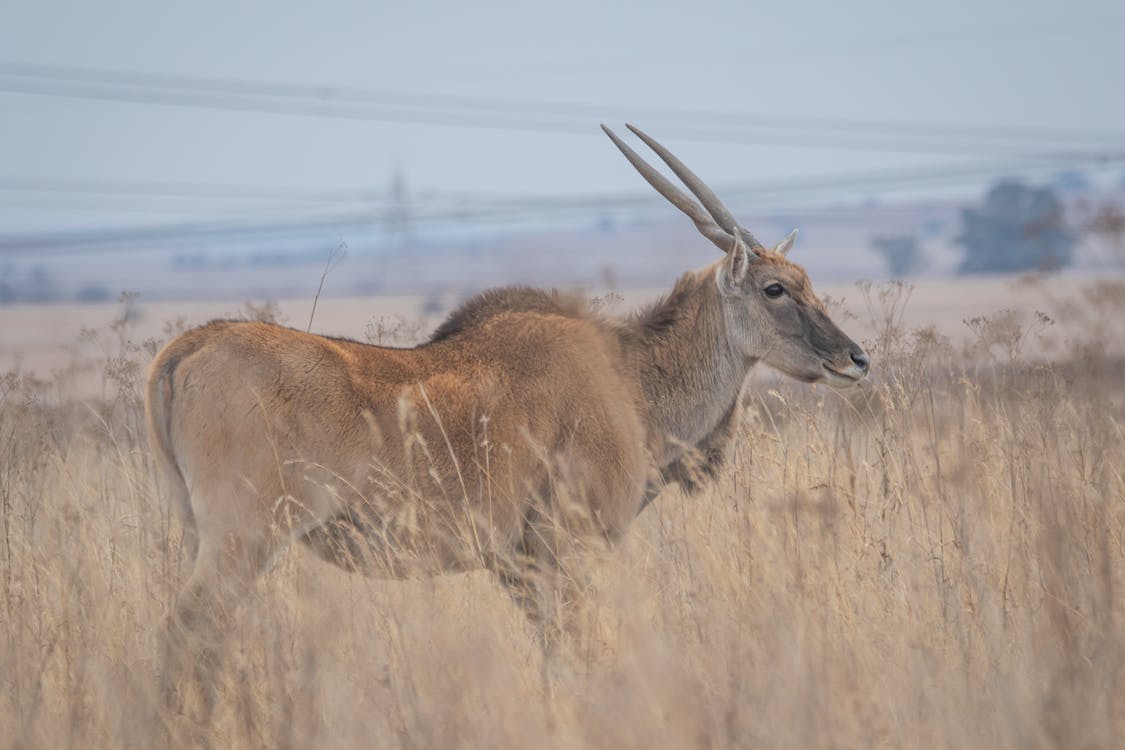Facing off against the eland remains a bucket list item for many hunters wanting to experience the ultimate in big game hunting. The largest antelope species in Africa offers hunters an unforgettable big game hunting adventure, with its size, elusive nature, keen senses and sheer strength making eland hunting an unforgettable game hunting adventure.
[DYNAMIC-BLOGTABLEOFCONTENT]
Key Takeaways
- The eland is Africa’s largest antelope and a sought-after big game hunting species.
- There are two main species of eland, namely the common eland, and then the Lord Derby eland, also known as the giant eland.
- The giant eland has two races, namely the Western giant eland and the Eastern giant eland.
- The common eland has three sub-species, namely Livingstone eland, the Cape eland and the Patterson eland.
- These antelopes are found in different regions of Africa due to preferring varying habitats, with different hunting seasons and methods.
- The common eland is listed with a status of “least concern” by the IUCN, while the giant eland’s status is that of “critically endangered.”
- Eland hunting is seen as challenging yet rewarding when harvesting Africa’s largest antelope, with a hunter’s skill, patience and determination paying off with an exceptional big game antelope.
- Hunting methods for the eland include amongst others, spot and stalk, walk and stalk, hunting from a blind and tracking opportunities.
- Ensure that your shot placement on this large antelope is spot on, to ensure a quick and humane death for the animal.
- Main predators for both species of eland include amongst others the lion, leopard, cheetah, and spotted hyena.
- There are various mounting options available for the eland, depending on what the hunter would prefer, from a simple wall mount to a life-size full mounting option.
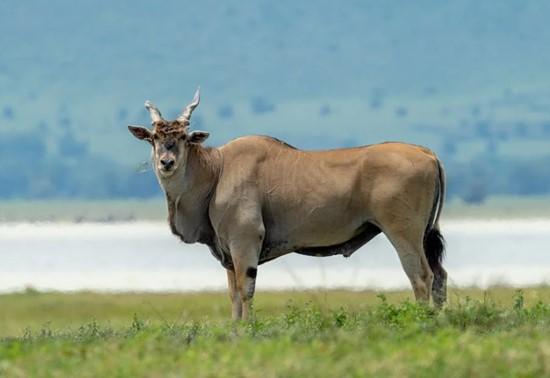
The Eland at a Glance
There are two main species of eland that are found in Africa, namely the Common eland (Taurotragus oryx), with sub-species of the Livingstone eland (T.o. livingstonii), the Cape eland (T. o. oryx) and the Patterson’s eland (T.o. patterstonii).
The Lord Derby eland (Taurotragus derbianus), also known as the giant eland, has two races recognized, namely the Western giant eland (T.d. derbianus) and the Eastern giant eland (T.d.gigas).
These magnificent species are found in different areas throughout the African continent.
The Common Eland
The Cape eland is a sub-species of eland and found mainly in South Africa. It can easily weigh up to a whopping 2,000 pounds. Also referred to as the common eland, this antelope is renowned for its strength and large size. In terms of habitat, the Cape eland is found in open woodlands and veld.
The Livingstone eland is found in several African countries including Mozambique, Namibia, Botswana, Tanzania, Zambia, and Zimbabwe.
The Patterson’s eland, also known as the East Africa eland, is found in East Africa, and occurs in countries such as Zambia, and Tanzania, amongst others.
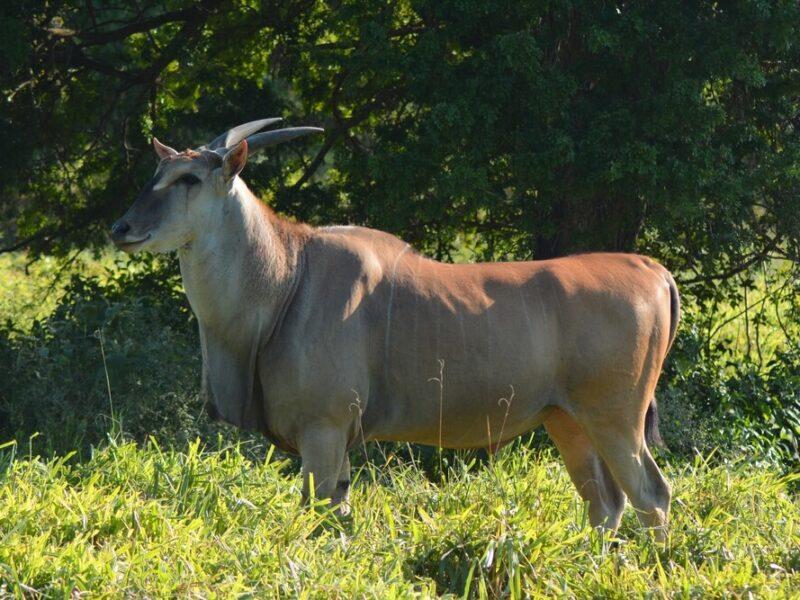
The Lord Derby Eland
The Lord Derby’s eland, also known as the giant eland, is Africa’s largest antelope. It has distinctly spiraled horns and a chestnut to brown colored coat. This giant antelope is found in west and central Africa in countries including Cameroon, Central African Republic, Chad, the Democratic Republic of Congo, Guinea, Mail, Senegal and South Sudan.
The Western giant eland inhabits Senegal, with its known habitat having diminished substantially.
The Eastern giant eland remains viable only in parts of the CAR, Cameroon, and South Sudan.
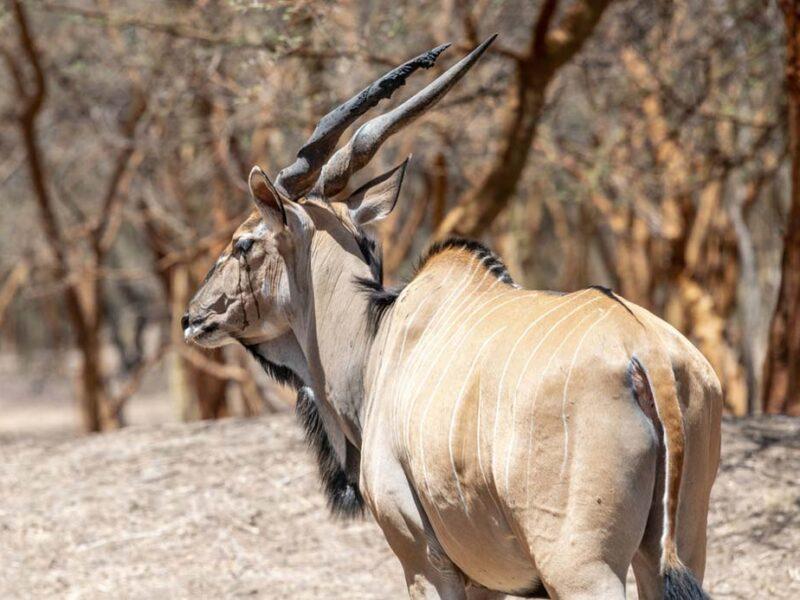
Best Hunting Seasons to Enjoy an Eland Hunt
Many destinations, like South Africa, allow year-round hunting opportunities, with no seasonal restrictions in place in terms of eland hunting.
The best time to consider hunting eland is largely dependent on their geographic location, for example the
Cape and Livingstone eland species, due to their habitat and locations, are best hunted from June to October, while those in search of the giant or Lord Derby’s eland, the best hunting time based on its hunting destination is from January to March.
Is the Eland Endangered?
The common eland is currently classified as with a status of “least concern” by the International Union for the Conversation of Nature (IUCN), with an estimated population of between 90,000 and 110,000 mature individuals across its range. While there are threats to this robust antelope, including the destruction of its natural habitat, poaching, as well as hunting, it is not currently considered endangered.
The giant eland, however, is listed as “critically endangered” with a population of between 8,400 to 9,800 mature adults. Its population has significantly declined due to habitat loss and poaching, with estimates suggesting only about 8,400 to 9,800 individuals remain. Conservation efforts are underway to protect this species
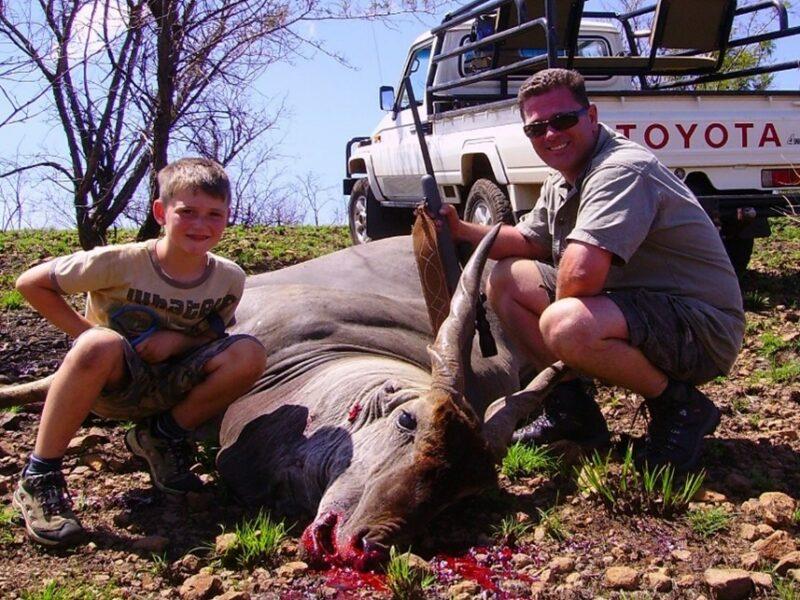
Eland Hunting: Is it a Challenge?
In a nutshell, yes. Don’t expect an eland hunting safari to be a walk in the park, as even with their large size, they are remarkably agile and can jump up to 8 feet in height from a standing position. Combine this with speeds of up to 25 miles per hour, and you have a big game antelope that uses these incredible abilities to navigate the various terrains of their habitats, escape predators, and move through their environment with surprising ease and speed.
Eland Hunts: The Challenges and Rewards
Eland hunts are known for being quite challenging for hunters, with the reward of harvesting this massive African plains game species being particularly rewarding.
Let’s look at some reason why hunting eland is seen as being so challenging:
Pure Brute Strength combined with their Enormous Size
Elands are amongst the largest worldwide and are the largest antelopes in Africa. They are a powerful species that requires significant skills to hunt and harvest.
Body Weight
Their enormous size and weight necessitates the use of high-caliber rifles and precise shot placement for a humane kill.
Agility
Despite its large size, the eland is remarkably agile, with an incredible jumping ability. They can (and easily do) clear 8 feet with ease, making cornering them a challenge on a big game hunting safari, as they often leap to safety while hunters may consider their prey cornered.
Speed
Despite their large size, they reach impressive speeds of up to 25 miles per hour, allowing them to evade a variety of predators and other danger.
Alert Behavior
Eland are naturally alert African plains game that see and evade hunters before they have even been spotted by the hunting party. The members of the herd are extremely alert, and threats of dangers are quickly shared amongst the group.
Habitat
The very habitats that the eland inhabits makes it a challenge for them to be tracked, as the variety of open savannas, dense woodlands and mountainous areas makes stalking and approaching them undetected quite difficult.
The Herd
Elands are often found in herds, making it even more difficult for hunters to zero in on one specimen within the herd without disturbing the whole group. So many sets of eyes and ears also on the lookout for danger makes approaching them without one of the herd alerting the others in the group quite a challenge.
Stamina & Endurance
Just to complicate an already challenging hunt, this African plains game species is renowned for its exceptional stamina and is easily able to cover long distances when pursued, without tiring.
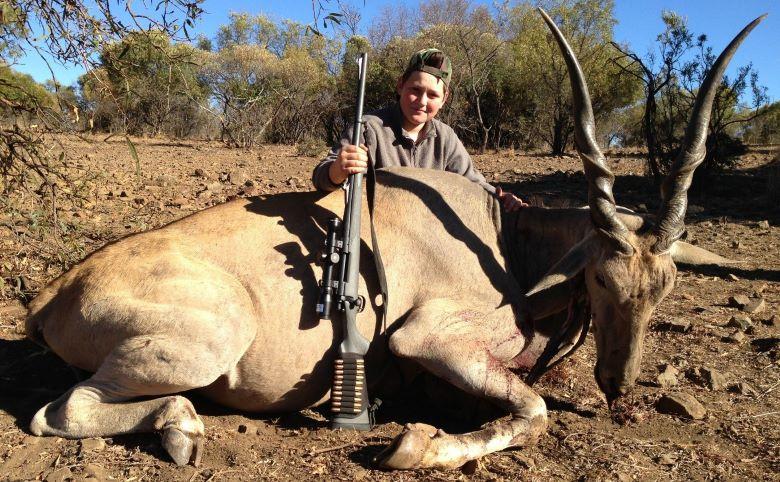
Hunting Methods when Hunting Eland
Eland hunting in Africa utilizes various hunting methods to target this great African plains game antelope.
Some popular and common hunting methods include:
- Spot and Stalk: When the eland is located a distance away, and the hunting party then approach it with care, to avoid being seen prior to being within a shootable range.
- Walk and stalk: Hunters walk through an area that is frequented by eland and start stalking their prey once they spot it in the area.
- Hunting from a Blind: This involves setting up a temporary blind near a water hole that the species is known to frequent, allowing the hunter to not only enjoy the beautiful African landscape while he waits, but also allows him to timeously take his shot, without the eland having an idea that danger is nearby.
- Tracking: Making use of expert trackers, eland hunting safaris can be a thrilling and exciting adventure as you track the antelope through the African bushveld.
Shot Placement when Eland Hunting
Due to the eland’s large anatomy, the hunter’s shot placement must be spot on to ensure a quick and humane kill. Shot placement is best when the heart and/or lungs are targeted. It is best to avoid head or neck shots when undertaking shot placement on this magnificent species.
Read more about shot placement on large African plains game antelope.
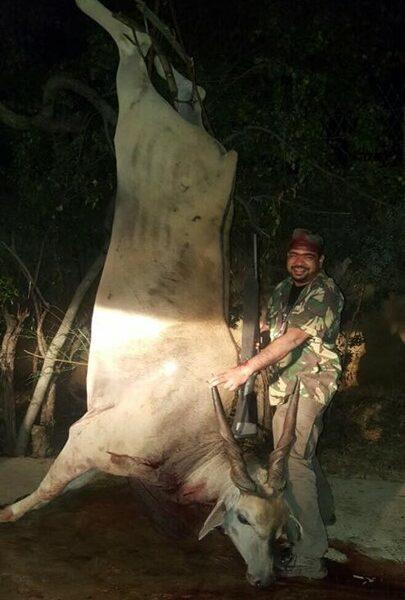
Beyond the Eland Hunt: Let’s Talk Mounting Options
When all is said and done, and the eland hunting safari is successful, you have a number of options to consider when it comes to mounting your big game antelope.
A couple of things to take into consideration when choosing your mounting option:
- The Taxidermist: Do your research and choose a taxidermist who is experienced in working with big game, as well as one that does quality workmanship. Ask your African outfitter who they would recommend, and research all your options before making a final choice.
- Local Regulations: Find out what legal regulations or requirements there are that need to be adhered to both locally and in your home country.
- Preservation Techniques: To ensure both the longevity of the mount as well as the quality thereof, discuss which mounting option would best suit you.
- Costs: Remember that there are numerous costs involved in terms of mounting an animal, discuss with the taxidermist which would best suit your budget and trophy room.
Eland Mounting Options
Shoulder Mount: Featuring the antelope’s head and shoulders, this is the most common type of mount for an eland, but a great way to show off its exquisite horns.
Full Body Mount: The advantage of a full body mount is that showcases the entire animal, often in a lifelike pose in its natural environment.
Pedestal Mount: This type of mount is similar to the shoulder mount, but in this case, it is secured to a pedestal base, which allows for 360-degree viewing of the game hunting trophy.
European Mount: The European mount is a minimalistic option that is often mounted on a plaque. Only the skull and horns are displayed, allowing the horns to be prominently displayed.
Wall Pedestal Mount: This is a combination of a wall mount and a pedestal mount, allowing the mount to extend from the wall.
Frequently Asked Questions
Where is the best place to hunt eland?
South Africa is a popular destination to hunt the infamous Cape eland, with the country’s drier areas being home to this magnificent big game species. The best hunting areas include the Eastern Cape’s mountainous regions, as well as the central parts of the country. Other popular locations include the southern and western parts of South Africa. A reminder that eland hunting can be extremely challenging, as this big game antelope has very good eyesight and senses.
What is the minimum caliber to be used when hunting eland?
The suggested minimum caliber is a 308, with anything smaller standing the chance of not being powerful enough to deal with the likes of this powerfully built African plains game antelope. The eland has a strong bone structure, with a powerful body and muscles, all of which need to be considered when choosing the correct caliber.
What is the biggest eland?
The giant eland, also known as the Lord Derby’s eland, is the largest species of antelope, with a body length ranging from 27.2–9.5 ft. There are two subspecies of the giant eland, namely the Western giant eland and the Eastern giant eland.
Is the eland bigger than the kudu?
Yes, the eland is bigger than the kudu and remains Africa’s largest antelope.
What are the eland’s predators?
Predators for the common eland include lions, leopards, African wild dogs, spotted hyenas, and cheetahs; while predators preying on the giant eland include lions, the Nile crocodile, spotted hyena, leopards, and cheetahs.

Conclusion
The eland remains one of Africa’s most prized big game hunting trophies, with hunters traveling from far and wide to bag this prized specimen. Eland hunting in Africa presents an exciting challenge for hunters seeking a memorable experience hunting one of the continent’s most majestic antelopes. While many may be under the impression that eland hunting may be quite straight forward and quite easy, this magnificent antelope challenges hunters to perform at their best to claim this exceptional African plains game antelope.
Author: B. Hershensohnn
